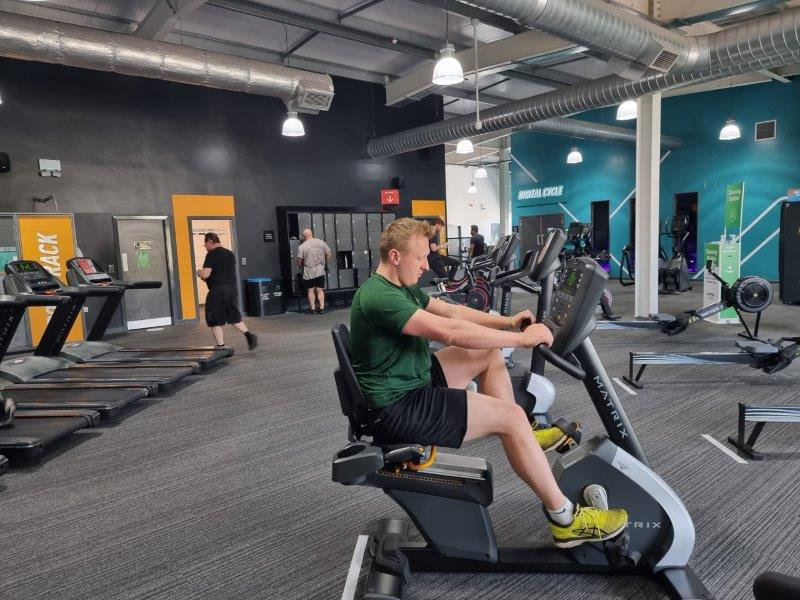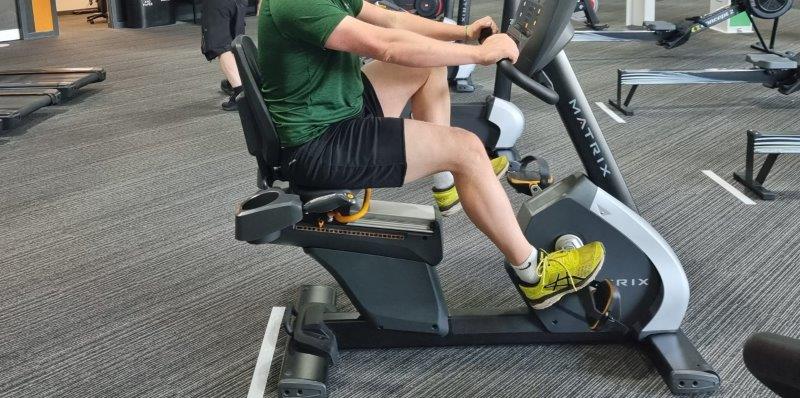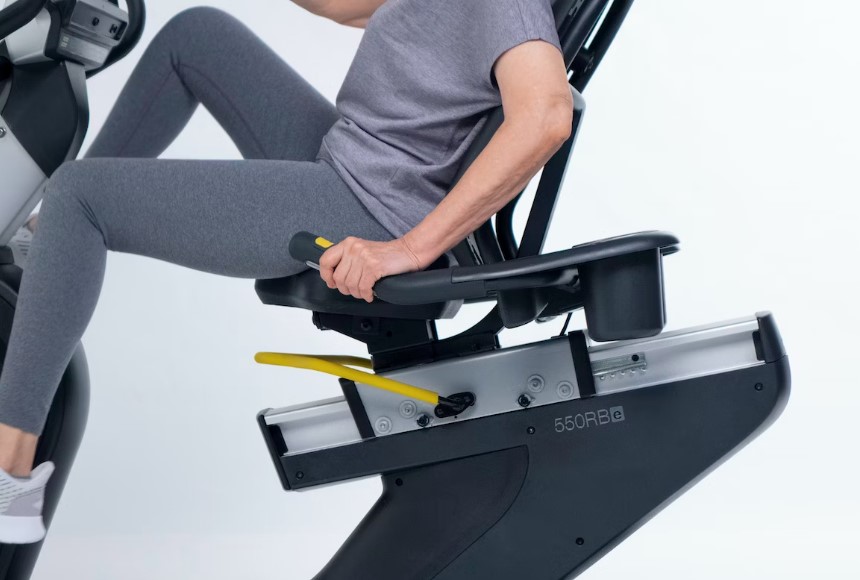Many of us love cycling, but it isn’t always a good option as we age or face some mobility issues due to injuries or strain. Luckily, recumbent bikes can be a great option for those looking for a more comfortable, low-impact cycling workout without exerting on the back..
Before you go running to the store, there are some things we think you should consider about buying a recumbent bike for your home or gym. Luckily, we have experts experienced with the use of recumbent bikes as part of their gym routine, so we’re here to share our expertise with you.
In this article, we’ll share with you everything we wish we knew before buying a recumbent bike when we first started out. This includes basic parts, things to consider before purchase, additional features, test ride basics, and where to buy one.
By using this guide, as well as the related articles below, we hope to help you make an informed decision about buying the best recumbent bike for your fitness needs.
Why Use a Recumbent Bike?
As you probably already know, recumbent bikes are specific types of exercise bikes where you sit in a reclined position, with your back supported with a backrest, and your legs extend forward to reach the pedals. They make for a great lower body workout, as they engage muscles in your thighs and legs.
Unlike a traditional upright bike, a recumbent bike has the pedals in front of you, rather than underneath you. These bikes also typically have wider and lower seats than traditional bikes, which make them more comfortable and ergonomic for people with limited mobility or back problems.
This is especially true if you’re wanting to exercise after an injury – other types of exercises can cause accidental reinjuries, but these bikes are much more gentle on your back and joints. Recumbent bikes tend to be safer than ordinary exercise bikes, thanks to their more stable and comfy design.
They can also be used for a variety of fitness needs including cardio exercise, weight loss, and endurance training. Because they’re easier to use than other types of exercise equipment, they’re a great choice for people at any stage of their exercise goals.

The Basic Parts of a Recumbent Bike
Recumbent bikes have different parts that we think you should be familiar with before investing in this type of equipment. You’ll be much better able to determine the quality of a bike or which features you want if you’re more familiar with the parts ahead of time!
Below is some basic information you should know about each of these parts.
Flywheel
The flywheel is the part of the recumbent bike that provides smooth pedaling and resistance. It is made of a heavy metal disk that is connected to the pedals of the bike, and can highly impact the quality of your exercising.
Heavier flywheels give a smoother and more stable ride, while lighter flywheels provide less resistance.
Some recumbent bicycles have adjustable flywheels which allow you to customize your resistance level according to your fitness goals, so you can adjust your workout difficulty.
Frame Material
Recumbent bikes can be made of a few different materials, including:
- Steel
- Aluminum
- Titanium
- Carbon Fiber
The material you choose for your bike will depend on your budget and individual preferences.
For example, if you want a bike that is lightweight and easy to move in your home, you may want to choose an aluminum frame. If you want one that is more durable and long-lasting, we would recommend choosing a steel frame.
Saddle
The seat, sometimes called the saddle, is an incredibly important part of your bike when it comes to safety and comfort. Recumbent bikes have wider and more padded saddles than traditional bikes, which can help support your weight more comfortably.
The more padded a saddle is, the more comfortable it will be for longer exercise routines. You should also consider bike saddles with contouring, as this can reduce pressure on certain parts of your body as you exercise.
Pedals
Since pedals are the most used part of your recumbent bike, you should consider the quality of the pedals on any bike you consider. Make sure the pedal system is adjustable for your height so you can exercise comfortably.
You should also consider if you want pedals with toe clips, or pedals that are clipless. Toe clips or straps help keep your feet in place as you exercise, while clipless pedals require you to wear special shoes that clip into the pedal for a more secure connection between your feet and the bike.
Things to Consider Before Buying a Recumbent Bike
Before buying a recumbent bike, there are a few important things we strongly recommend you consider to make the most informed decision possible. Below are some things you should try to keep in mind before making a purchase, as they’ll make a big impact on the experience you get with your bike.
Intended Use
The first thing you should think about before looking for a recumbent bike is your intended use with the machine. Consider which of the following you plan to use your bike for:
- Cardiovascular Fitness
- Physical Rehabilitation
- Weight Loss
- Low-Impact Workouts
- High-Intensity Workouts
Your intent behind the machine will help you determine which type of bike is best for you.
For example, those wanting a recumbent bicycle to lose weight will want to find one that has a variety of workout programs or resistance levels to adjust according to their goals.
Meanwhile, if you’re looking for a simple, low-impact workout, you should probably concern yourself more with the support of the saddle and pedals.
Adjustment Points
A good exercise recumbent bike will have several adjustment points so that you can adjust the bike according to your body shape and size. Some of the most common adjustment points on recumbent bikes include:
- Seat height
- Seat position
- Pedal distance
- Handlebar height
- Resistance level
Make sure that any recumbent bike you invest in is able to be adjusted at each of these points so that you know you’ll be able to work out comfortably on it.
Size
Before bringing home a giant recumbent bike, you need to consider its size, as well as the size of the space you have available for it.
Before going shopping, be sure to measure the space you have for the bike at home or in your gym, including floor space and ceiling height. You don’t want to bump your head while exercising!
Recumbent bikes typically range anywhere between 46 and 67 inches in length, and 18 to 30 inches in width. They also average around 45 inches in height, so be sure to calculate how high of an area you need including your upper body.
Remember that the larger your bike is, the heavier it will likely be. Even if you have a big space for your bike, you may still opt for a smaller size to make moving and folding much easier on you.

Weight Capacity
Weight capacity is an incredibly important factor to consider, as using a piece of equipment over its weight capacity could result in accidental injury. Most recumbent bikes can typically support anywhere between 250 to 400 pounds, though some with stronger frames may be capable of holding more weight.
Keep in mind that you should also account for any additional weight that the bike will hold, including any additional equipment you bring with you as you exercise, such as a water bottle.
Plus, the greater the weight capacity, the more durable the bike likely is, so it may be longer lasting than bikes with smaller weight capacities or cheaper frames.
Comfort
One of the top things you should keep in mind as you shop for a recumbent bike is your comfort. You want to be able to exercise stress-free, so being comfortable while you work out is incredibly important!
One of the biggest things when it comes to comfort is the quality of your bike’s seat or saddle. The more cushioned the seat is, the comfier it will likely be for longer workouts. You should also make sure the seat has good lumbar support and that it conforms well to your body shape.
You also want to make sure you’re comfortable using other parts of the bike, such as the pedals and handlebars. Do your feet stay on the pedals easily, or do they slip out frequently? Do the handlebars have any grip or cushion to support your hands while you work out?
The comfier you are during your workout, the more pumped you’ll be to come back for another.

Console
The console is the part of your recumbent bike that gives you information about your workout. This information can include speed, distance, time, calories burned, and heart rate.
Make sure you find a console that is clear to read and can easily be adjusted according to the type of workout you want.
If you want more from your console, look for one with additional features such as USB charging ports or Bluetooth connectivity to listen to your best workout music to hype you up as you accomplish your fitness goals.
Budget
Of course, you need to consider your budget before buying a recumbent bike. Exercise equipment isn’t cheap, so you’ll want to be realistic about the type of equipment you’re able to afford.
Entry-level recumbent bikes can cost anywhere between $200-500. Typically, these bikes are quite simple and don’t have as many features as more expensive bikes. However, they do work well for those wanting the simplest version possible.
Mid-range recumbent bikes usually cost between $500-1,000, depending on the features you’re interested in most. These bikes tend to have more durable construction as well, so they’ll like last you longer than cheaper bikes will.
High-end recumbent bikes can cost anywhere up to $2,000 or more, and typically have top-of-the-line features such as interactive displays and the highest quality materials possible. If you want the best of the best, you can expect to pay at least a few thousand dollars for it.
Remember that your bike should fit within your budget, but also give you the features you need to meet your fitness goals. Though the cheapest option may be tempting, it may not give you the features you want.
Always consider all options available before making a final decision.
Warranty
Finally, you should consider any warranty that your recumbent bike comes with. Warranties for these bikes can vary widely depending on the manufacturer and model of the bike you choose. Some of the things you should look into in a bike’s warranty include:
- Length of coverage
- Type of coverage
- Transferability
- Exclusions
- Customer service reputation
Always make sure you clearly understand what parts are covered and for how long under a warranty, as well as any exclusions to the warranty, such as damage from misuse.
Plus, a warranty with transferability can help add value to your bike if you ever plan to sell it, depending on the length of coverage and how long you own the bike yourself.
Remember that the best warranties include clear accessibility to helpful customer service. Be sure to purchase a bike from a reputable company known for solid customer service assistance.
Safety Precautions
We recognize that hopping on a recumbent bike isn’t necessarily for everyone. If you have concerns or are recovering from an injury, you should first consult with a healthcare professional about whether a recumbent bike exercise routine is good for you.
If your physician decides you can use one, you should be sure to start any workouts slowly and progress gradually. Make sure you’re starting off with a low-intensity routine, so you don’t risk reinjuring yourself. The last thing you want is to strain yourself.
You should also be sure to warm up and cool down properly. Warm up your muscles with some light stretching, and do the same after your workout to cool down. This can help prevent any tension that can arise from your cycling.
Make sure you listen closely to your body any time you exercise, no matter what equipment you’re using. If something doesn’t feel right, stop your workout and contact your doctor.
Additional Features
Some recumbent bikes have special features in addition to those listed above for consideration. These are three of the most common additional features offered in exercise recumbent bicycles.
Built-In Displays
While most recumbent bikes have some sort of console, some high-end bikes have full built-in displays with screen and color. These displays can play sound and video, so you can watch your favorite exercise video while you work out. Or, you can just put on your favorite Netflix show!
Exercise Programming
Some bikes come with pre-installed exercise programming, so all you have to do is press a button for a full workout. This can include changes in resistance or intensity.
If you get a bike with a built-in display as described above, you may also find pre-installed exercise videos at your fingertips. These videos are likely tailored to your specific bike, so you know you’re getting instruction that works.
Test Riding a Recumbent Bike
Before making a purchase, you should always test out a recumbent bike you’re interested in to determine if it’s comfortable for your needs. Always make sure you’re wearing comfortable clothes and shoes you would normally wear for a workout, so you can get a true sense of how the bike will feel while you exercise.
These are the three main things you should keep an eye out for when test-riding a recumbent bike.
Stability
Any recumbent bike you try should be stable while you work out. Make sure the bike is adjusted properly to your body size, including the seat height and pedal distance. Then, see how stable the bike is as you work out.
If the bike is at all unstable or wobbly, you should consider a different bike.
You should also consider your stability in terms of comfort while sitting and pedaling. Make sure you check for support on your bottom and back, so you know you’ll be able to exercise for longer periods of time.
Resistance
Always check out the resistance levels in a potential recumbent bike. Some bikes have more resistance levels than others, so you should be sure to check out all of the options the bike has to make sure it will fit your exercise needs.
You should also make sure the bike can easily adjust its resistance as you exercise, so you don’t have to wait long for your program to change.
Noise Levels
Always be sure to consider the noise level of your recumbent bike, both for your sake and the sake of others in your home. Some bikes are noisier than others, so you’ll want to listen closely as you test the bike.
Remember that you can reduce some noise by placing the recumbent bike on an exercise equipment mat, but this won’t do much for a machine that is truly just loud.
Useful Recommendations Based on Your Needs
Recumbent Bikes by Pricing
- Best Cheap Recumbent Bike
- Best Recumbent Exercise Bike Under 200
- Best Recumbent Bike Under 500
- Best Recumbent Exercise Bike Under 1000
- Best Affordable Recumbent Bike
- Best Value Recumbent Bike
Recumbent Bikes by Age and Size
- Best Recumbent Bike For Seniors
- Best Recumbent Bike For Obese
- Best Recumbent Bike For Short Legs
- Best Recumbent Exercise Bike For Short Person
- Best Recumbent Bike For Tall Person
- Best Recumbent Bike For Overweight
- Best Recumbent Exercise Bike For Over 300 Lbs
Recumbent Bikes for Specific Workout Needs
- Best Recumbent Bike With Arm Workout
- Best Recumbent Bike For Bad Knees
- Best Recumbent Bike For Back Problems
Recumbent Bike for Home Use
- Best Recumbent Bike For Home Use
- Best Folding Recumbent Exercise Bike
- Best Indoor Recumbent Bike
- Best Stationary Recumbent Bike
Recumbent Bike for All Other Uses
- Best Recumbent Bike
- Best Recumbent Elliptical
- Best Commercial Recumbent Exercise Bike
- Best Rated Recumbent Exercise Bike
- Best Recumbent Exercise Bike
Conclusion
We know that recumbent bikes are a great option for those looking for a comfortable, low-impact workout.
When deciding to purchase a recumbent bike, remember to consider the important factors we mentioned above, such as comfort, budget, and additional features to make the most informed decision possible.
By doing your research ahead of time, you can make sure you find the perfect bike for all your workout needs, so you’ll be one step closer to accomplishing your fitness goals!
